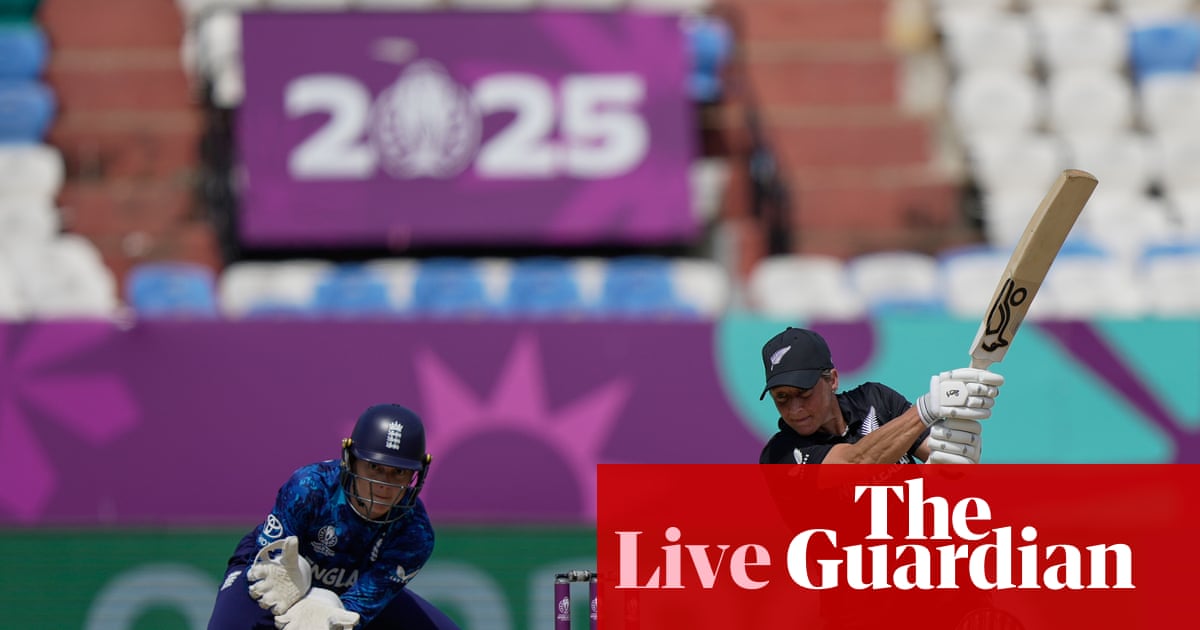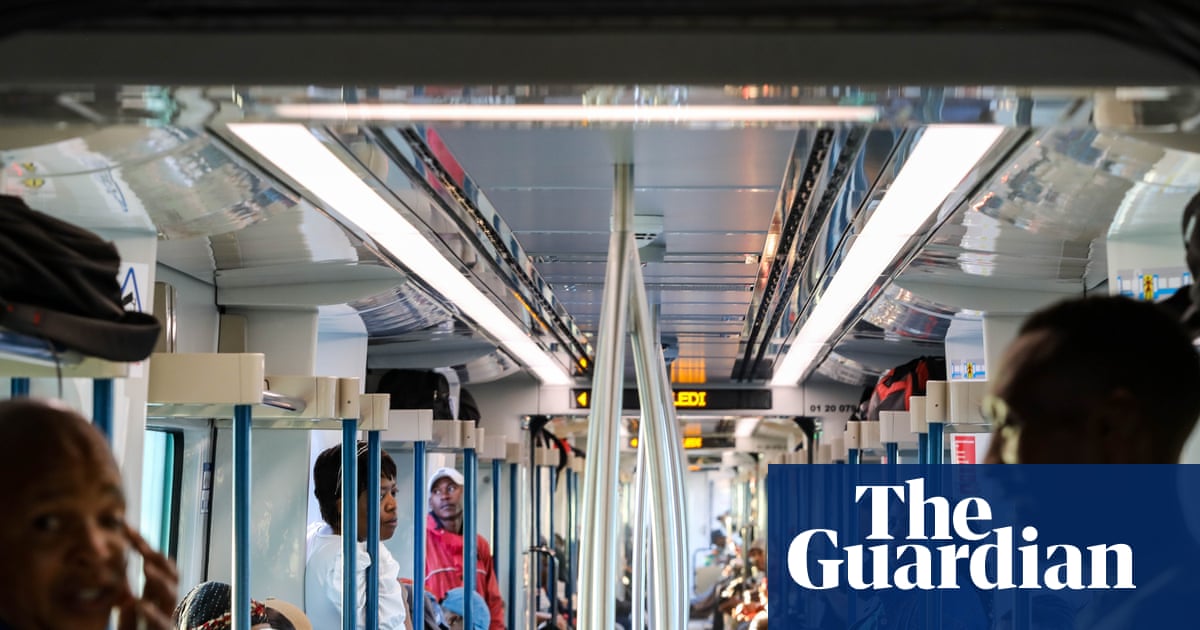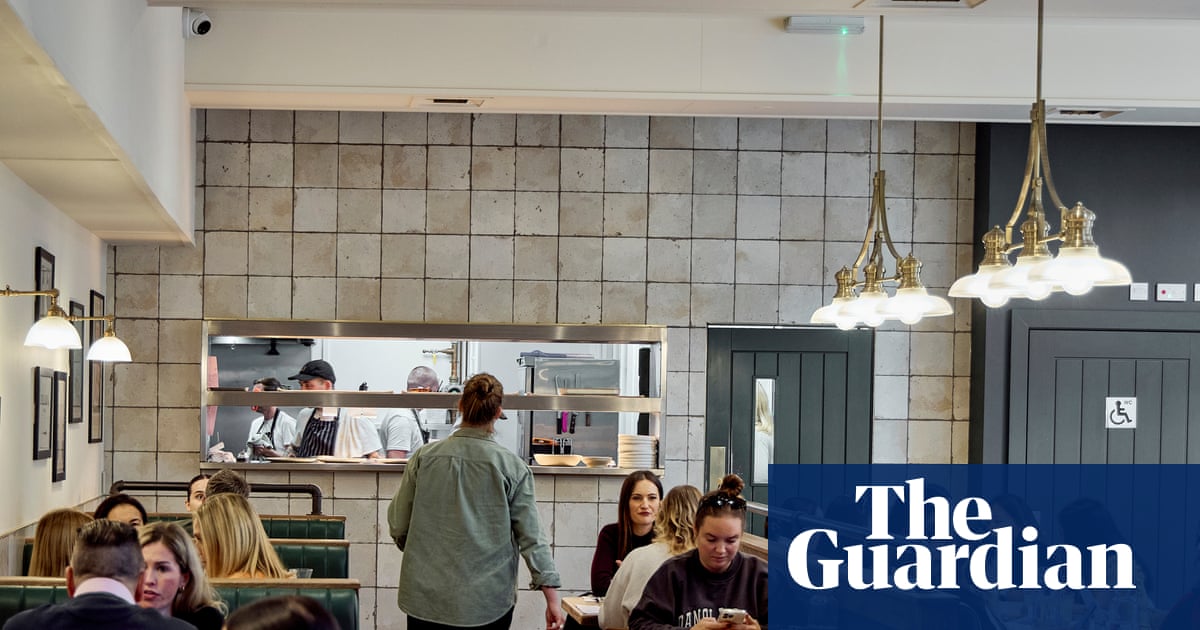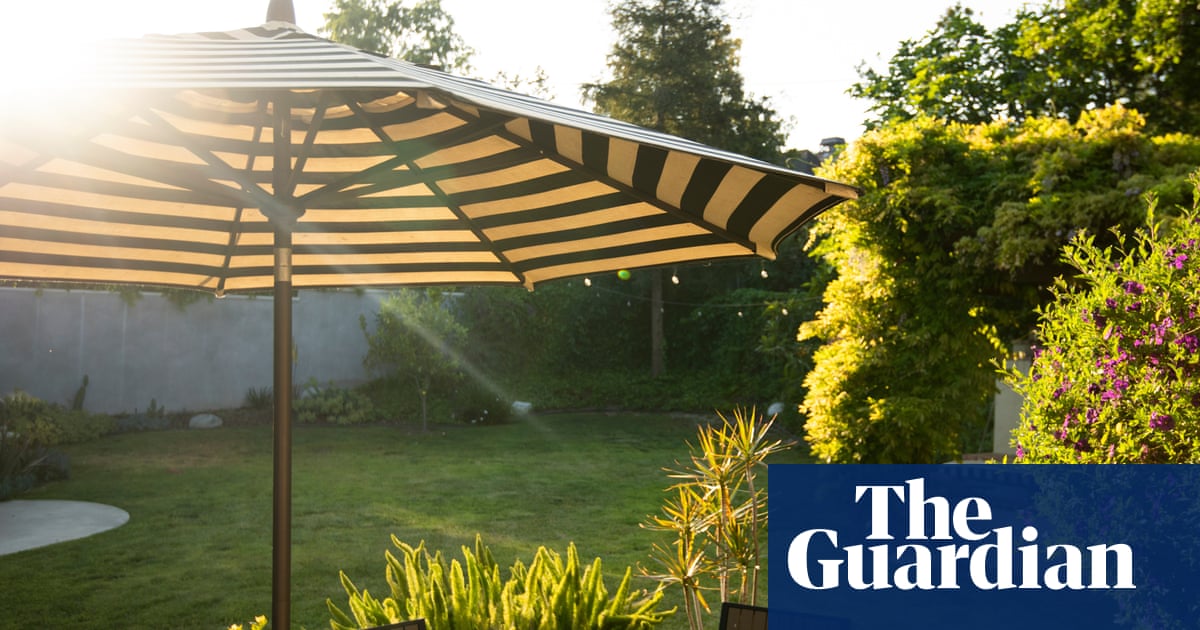If you’ve always thought a french press was a euphemism for a passionate snog outside a boulangerie, then you’ll be disappointed to hear that this article is purely about coffee brewers. Cafetières, to be specific. Or, to give the French invention its full name, the cafetière à piston. You may know it as such – or as a french press; the brewing device, not the street rendezvous – but regardless, it’s a cheap, simple and brilliant way to brew coffee. Or tea, if you’re so inclined.
The cafetière is, deservedly, many people’s go-to brewer in the morning. You blearily grab it from the cupboard, heap in a few tablespoons of coffee – or lazily tip straight from the bag – and pour over some boiling water. A few minutes later, all that’s left is a final stir and a torturously slow plunge before the freshly brewed coffee pours into the cup.
You can pick up a basic cafetière for about a tenner, but spending more can get you a prettier model – or open the door to insulated models that keep your coffee hot for a couple of hours. Pricier designs may now employ double filters, too, to keep the coffee free of murky residue.
I’ve tested 10 of the best french presses over the past couple of months, and these are my favourites.
At a glance
-
Best cafetière overall:
Bodum Chambord
-
Best budget cafetière:
John Lewis stainless steel cafetière
-
Best affordable insulated cafetière:
ProCook double-walled cafetière
-
Best insulated cafetière for camping:
Yeti Rambler french press
-
Best cafetière for beautiful design:
Bodum Columbia
-
Best cafetière for enthusiasts:
Espro P7
Why you should trust me
I’ve been reviewing coffee appliances and paraphernalia for years now, including everything from grinders to four-figure espresso machines. I drink a lot of coffee, too, with most days powered by thermal carafes full to the brim with filter coffee, the occasional guilty latte macchiato from the Nespresso machine and – during heatwaves – cold-brew experiments diluted by desperate handfuls of ice.
How I tested
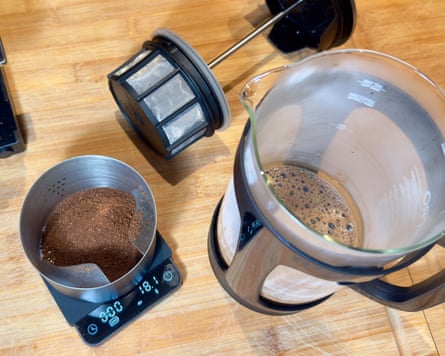
It’s controversial, but primarily I used the cafetières to brew coffee. I brewed coffee with every model here using freshly ground, medium-coarse coffee.
In terms of brewing, I (mostly) followed former world barista champion James Hoffmann’s guidelines. Boiling water, four minutes of brewing, stir and wait another five minutes. Then depress the plunger so that it’s just beneath the top of the brewed coffee.
Crucially, for the insulated models, I tested their heat retention, taking temperature readings in 20-minute intervals up to an hour and beyond. You’ll find the results quoted in the reviews and the specifications beneath each.
The best cafetières
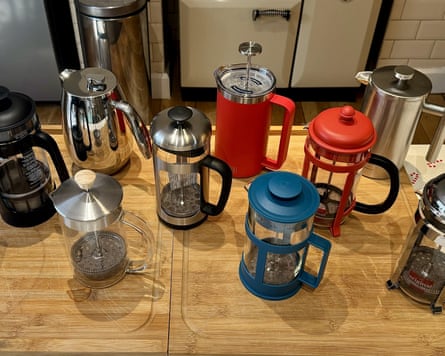
Best cafetière overall:
Bodum Chambord
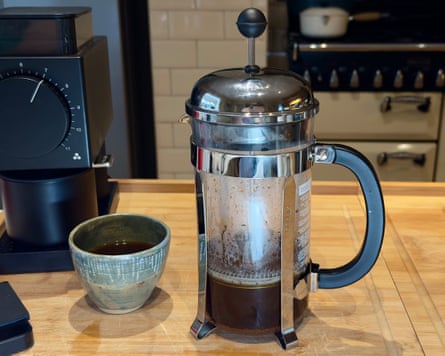
Close your eyes and picture a cafetière. You’ve probably just imagined the Bodum Chambord. A shiny metal frame and lid with a large, black handle and a plunger crowned by a black plastic ball.
Why we love it
This is a design classic. You can take your pick of 0.35-, 0.5-, 1- and 1.5-litre sizes, and there’s an array of different colours and slight design variations. Our favourite is the old-school chrome, silver and black version.
The metal frame and solid plastic handle feel sturdy, the glass carafe fits snugly in place, and the lid, filter and plunger all feel nice and solid. The lid and filter are modular, so you can unscrew the filter and separate the metal filter to clean out trapped coffee grounds.
There’s nothing special going on here. It’s a design that works, and the parts are all a standard size, so you can replace the carafe and plunger if they crack or snap a few years down the line.
It’s a shame that … if I have to quibble, then I could point to the fact that the all-metal filter is prone to letting coffee sludge through if you don’t pour carefully – or if you want every last drop from the carafe.
It’s also expensive for what it is. If you’d prefer a cafetière that keeps coffee warm for longer, then you could buy something like ProCook’s model for similar money. If you simply adore the Chambord silhouette, wait patiently for a sale.
Dimensions: 23 x 38 x 34cm (WDH)
Weight: 644g
Quoted capacity: one litre
Tested brewing capacity: 940ml
Dishwasher safe? Metal and glass components, yes; the rest, hand-wash only
Best budget cafetière:
John Lewis stainless steel cafetière
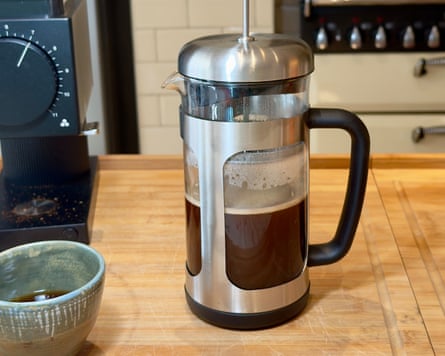
Yes, I know. A £25 cafetière hardly qualifies as cheap. But compared with the cheaper models here, John Lewis has put together a much sturdier-feeling cafetière with a classic profile. For the money, it’s good value.
Why we love it
Love is a strong word. Pleasingly inoffensive is closer to the mark. The design is nowhere near as pretty as the Bodum Chambord, but it feels solid and looks fine.
The metal frame and plastic base add welcome protection to the glass carafe, and the plunger and lid are a standard size. It all comes to pieces for easy cleaning or replacement.
And yes, it brews a decent coffee. The classic all-metal filter does a good job of keeping grounds out of the brew if you plunge carefully, and the metal frame uses circular cutouts to maintain rigidity. The cheaper models here use thinner metal with bigger gaps, and are far more flexible.
The one-litre capacity isn’t overly optimistic either, so you’ll get about 950ml of coffee from a brew without risking grounds overflowing when you plunge.
It’s a shame that … it’s just such a boring design. I feel like a basic cafetière such as this should be about £10 cheaper – and rather snobbishly, I’d be tempted to shop around for a discounted Bodum. If you’re looking for a basic cafetière that should last, though, it’s a safe pick.
Dimensions: 15 x 10 x 23cm (WDH)
Weight: 590g
Quoted capacity: one litre
Tested brewing capacity: 950ml
Dishwasher safe? Hand-wash only
Best affordable insulated cafetière:
ProCook satin double-walled cafetière
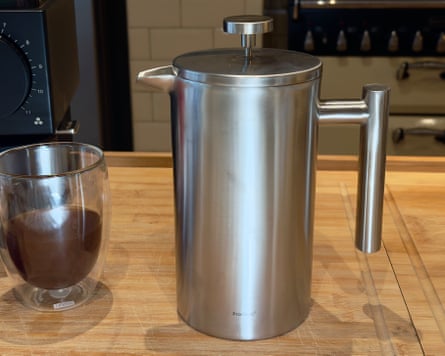
ProCook has made a name for itself with affordable, good-quality kitchen gear, and its cafetière is a basic insulated model that retails for a sensible RRP of £40. It’s a generic rebadged design that we’ve seen from various brands – George at Asda, John Lewis and VonShef – but it keeps coffee hot and is more robust than glass models.
Why we love it
You can choose between a 350ml model and the one-litre model we have here. The modern, minimalist styling looks good, although hardly unique. Apart from the tiny ProCook engraving on the bottom, it’s vanishingly different from other rebranded versions on the market.
The metal casting is quite rough and ready in some places, around the spout for instance, but it feels solid. This is a cafetière you can drop, bash and abuse for years without destroying it. The use of a standard-size modular plunger and lid means you can replace parts as and when required.
Heat retention isn’t quite as good as the best here, but it’s far better than a glass alternative. After one hour, the temperature had dropped to 67C. After two, it was 54C.
Coffee brewing is fine, but the use of a metal filter means you need to be a little careful not to pour too roughly, or you’ll get sludge in your cup.
It’s a shame that … at this price, there’s not much to complain about. The use of a standard metal filter in tandem with a metal carafe means you may end up scratching the metal over time, though. This may require you to occasionally clean off any sticky coffee residue.
It does brew slightly less than rivals, too. I suggest you’ll struggle to get more than 890ml out of the ProCook without spilling it during plunging. This is a minor quibble, however. For £40, or less while discounted, you’re getting a virtually unbreakable cafetière that keeps coffee hot for longer than a standard glass cafetière. If you can find a suspiciously similar-looking model with a different brand name, though, give it a go – it’s almost certainly identical.
Dimensions: 18 x 11 x 20cm (WDH)
Weight: 825g
Quoted capacity: one litre
Tested brewing capacity: 890ml
Temperature after 60/120 minutes: 67C/54C
Dishwasher safe? Yes
Best insulated cafetière for camping:
Yeti Rambler french press
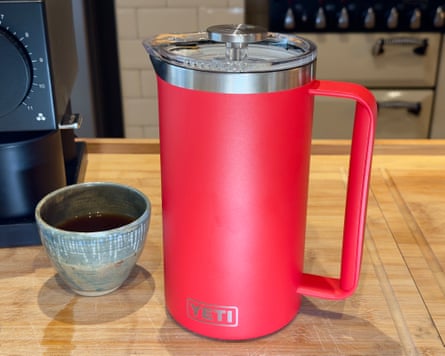
Yeti’s family of reassuringly expensive outdoor gear includes the Rambler french press. It’s a familiar recipe: tough materials, eye-catching bright colours and good performance. And, naturally, a three-figure price.
Why we love it
The build is spectacularly solid, and this is matched by superb thermal qualities. Yeti is the only brand here to use double-wall vacuum insulation, and this was clear in our testing. Even after an hour, the temperature was a piping-hot 71C, and it was the only cafetière to keep temperatures above 60C for two hours.
You can choose between this one-litre and a 1.9-litre (about £130) model, and take your pick from a range of colours including navy, pink, red and white, plus limited-edition colours such as black forest green and ultramarine violet.
Yeti’s GroundsControl filter uses a rubber plate above the filter to attempt to stop the brewing process once you’ve plunged it. This works pretty well and combines with the rubber-sealed filter to keep coffee sludge to a bare minimum.
Unfortunately, the pouring spout doesn’t self-seal, nor is there a closing mechanism, so it doesn’t stay warm for even longer. Campers should note that the lid catches rain and allows it to pour into your brew, and it’ll spill easily if you knock it over. You can spend another £13 on the Yeti MagSlider lid to add a seal, but at this price, it should come as standard.
It’s also heavy. It’s one of the smallest one-litre cafetières here, and only brews about 850ml of coffee, but fill it to the brim and it weighs more than 2kg. If you’re weak of wrist, you may not appreciate this.
It’s a shame that … the price is daunting, although the quality does go a long way towards justifying the expense.
Dimensions: 15 x 11 x 21cm (WDH)
Weight: 1.2kg
Quoted capacity: one litre
Tested brewing capacity: 850ml
Temperature after 60/120 minutes: 71C/62C
Dishwasher safe? Yes
Best cafetière for beautiful design:
Bodum Columbia
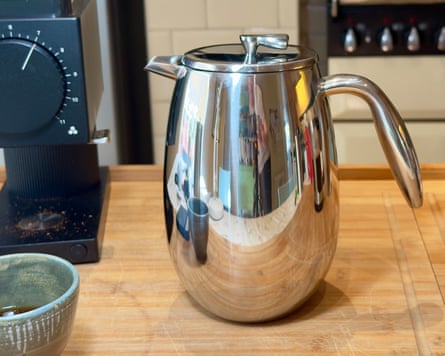
This is by far the prettiest insulated design here. The polished belly and handle that flops off to the side are simple and elegant, and the insulating qualities are on a par with most of the brands here – apart from Yeti.
after newsletter promotion
Why we love it
As with all Bodum cafetières, you can choose a size that suits you. There are 0.35-, 0.5-, 1- and 1.5-litre models, and each has the same design with a slightly taller and thinner, or squatter profile.
The all-metal design feels sturdy and doesn’t have the uneven edges or cheap casting you’ll see on budget all-metal cafetières. It uses a dual-wall construction to help retain heat, and this works well. After an hour, temperatures dropped to 68C; after two, 54C.
The metal lid and keyhole-shaped plunger handle are unique, but the filter is the same plastic-framed type as found on Bodum’s cheaper Java models. This isn’t a bad thing, though: it uses plastic rather than a metal seal around the edge to save scratching the metal interior, and this is noticeably better at preventing sludge from pouring into the cup.
The plunger comes in three parts, so you can unscrew it and replace the filter, plunger or lid. It also uses a slightly more sturdy-looking metal screw connector, rather than plastic.
It’s a shame that … it’s expensive. If you prize prettiness as highly as hot coffee, though, then you may not mind the expense – and what’s more, there are no glass carafes to break or replace. If you like the idea of stylishly serving after-dinner coffee to your favourite guests, then what better way to do it?
Dimensions: 20 x 13 x 21cm (WDH)
Weight: 937g
Quoted capacity: one litre
Tested brewing capacity: 930ml
Temperature after 60/120 minutes: 68C/54C
Dishwasher safe? Yes
Best cafetière for enthusiasts:
Espro P7
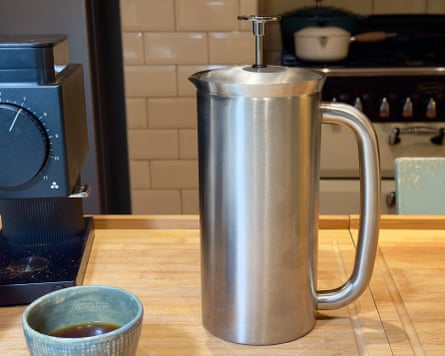
Espro makes lovely french presses with a twist: the brand uses dual filters to banish as much coffee gunge as possible. This model, the P7, is its premium insulated model.
Why we love it
The dual filters clip together, providing one layer of fine mesh and a second layer of ultra-fine mesh. This is backed up by a twin silicone seal around the edges to obstruct sludge as much as possible. You even get paper filters in the box to provide further filtration.
It works, too. Even without the paper filters, I measured less coffee residue after pouring every last drop out of the P7. It’s not perfect, though – some grounds get through if you pour out every last drop, as I did in my testing.
The tall, 1.2kg design may be a bit much for weaker wrists, but it does feel super sturdy and heat retention is good – if no better than the cheaper insulated models here. Happily, though, capacity is ample. Espro claims a maximum of 946ml as it uses a US 32oz sizing, though the actual brew size is closer to a litre.
It’s a shame that … the clever dual filter design ties you into Espro parts. The carafe and plunger are a non-standard width, so you’ll have to buy Espro replacements, which are available on the website. And unlike other designs, the dual filter also locks some brewing water in with the grounds. This makes for messier cleaning.
If you’re a coffee and tea fan who simply hates gunge in the cup, the Espro design is better than the others here. For less fussy, budget-conscious buyers, a cheaper cafetière is a better buy.
Dimensions: 16 x 11 x 26cm (WDH)
Weight: 1.2kg
Quoted capacity: 946ml
Tested brewing capacity: 990ml
Temperature after 60/120 minutes: 67C/53C
Dishwasher safe? Yes (website clarifies as top-rack only)
The best of the rest
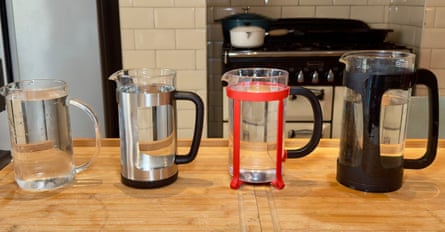
Espro P3
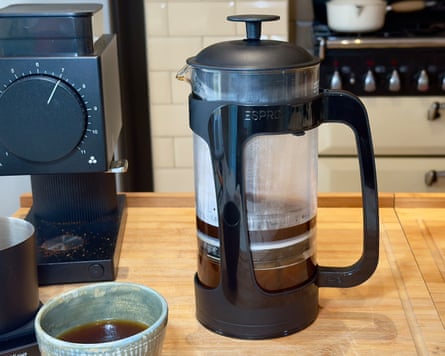
Best for: enthusiasts who hate sludge
This is Espro’s entry-level cafetière, and it’s actually very good. The dual filters hold back more sludge than all the other brand’s cafetières, and that means you get a slightly cleaner cup. The more refined brewing does, however, come at a cost, in that the P3 feels plasticky and a bit cheap.
Make no mistake, the dual filters work well. There’s far less coffee residue than you get with other standard filters, and you can get a little more coffee from each brew without having to pour really carefully. The issue is that many buyers probably don’t care.
Indeed, this is quite a lot to spend on a predominantly plastic cafetière. The P3 very much feels like a cafetière that’s been built to a tight budget. It doesn’t look particularly attractive, and the plastics just feel a tad rattly and basic.
It’s not badly made, but it’s more than 25cm tall – so may not fit into standard cupboards too easily – and the extra cleaning required for the dual filters may actually be more off-putting to less fastidious coffee drinkers. You’re also tied into using Espro parts as the carafe and plunger are non-standard sizes.
If you’re a coffee enthusiast, however, the P3 is an affordable way to try Espro’s dual filters. It’s all a matter of perspective.
It didn’t make the final cut because … it’s too expensive for most people.
Dimensions: 15 x 11 x 25cm (WDH); weight: 632g; quoted capacity: 946ml; tested brewing capacity: 1,100ml; dishwasher safe? Yes (website clarifies as top-rack only)
Ikea 365+ coffee/tea maker
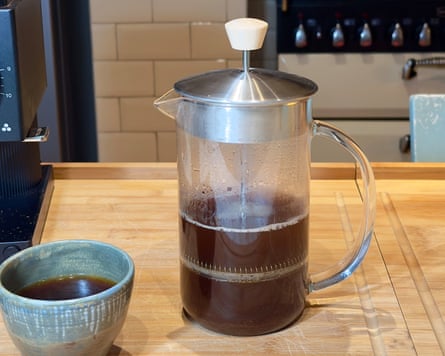
Best for: people who are walking around Ikea and need a cafetière right now
Ikea’s cafetière looks good. The all-glass carafe is an interesting twist, and the combination of a brushed-metal lid and wooden plunger handle makes for something that looks a little more expensive than £15. You even get a little cork mat to put under the carafe. Cute.
There are no complaints about the function here: this makes coffee. Nice coffee. The brewing capacity is on the low side, however. I fit a litre of water into it, but once I added coffee into the equation, I was able to brew about 850ml at a push.
This is a cheaply made thing. The little wooden handle screws on top of the metal shaft, but it was wonky right out of the box. It also tries to unscrew itself every time you touch it. The plunger and lid all come to pieces so they’re easy to replace, but they feel light and cheap, too.
The cork mat is another negative. Because it’s not attached, you’re very likely to lose it. And once you do, you’ve got to wonder how long the exposed glass bottom and glass handle will last under normal use. I’m clumsy, so I know this is a cafetière that would not last long in my home.
It didn’t make the final cut because … I would spend a little more on the John Lewis cafetière instead.
Dimensions: 14 x 10 x 20cm (WDH); weight: 466g; quoted capacity: one litre; tested brewing capacity: 850ml; dishwasher safe? Metal and glass, yes; wood, hand-wash only
Habitat eight-cup cafetière
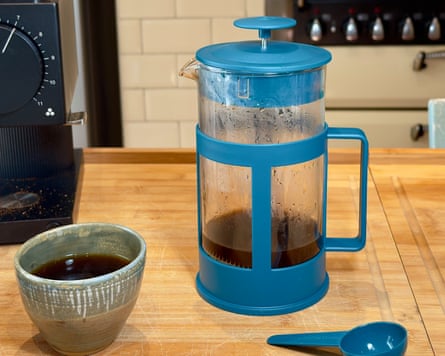
Best for: an ultra-cheap cafetière
This Habitat cafetière is cheap and it brews coffee. It’s a standard-size carafe and plunger, too, so when bits break or wear out, you should be able to find suitable replacement parts easily – although this may end up costing more than the cafetiére itself.
This is bargain basement stuff. The plastics are a bit wonky here and there – look closer, and you can see the moulding imperfections. While writing this review, I also noticed that the filter was slightly skewwhiff – this let a few coffee grounds escape into the brew. It may have been that way from new, but gently bending it back was a simple fix.
That said, the filter’s thin metal frame won’t take too much encouragement to bend back again, so I’d be careful not to use too fine a grind, or you may need to press harder than the plunger can handle. I also broke the carafe while trying to clean it. The plastic shell was so tight that it cracked when I tried to slide it out. Nota bene.
It didn’t make the final cut because … build quality is mediocre.
Dimensions: 13 x 10 x 21cm (WDH); weight: 458g; quoted capacity: one litre; tested brewing capacity: 940ml; dishwasher safe? Hand-wash only
What you need to know
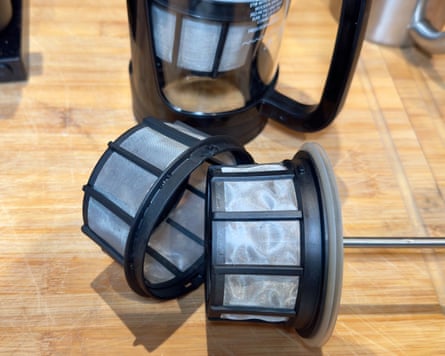
Are all cafetières the same?
Broadly speaking, yes. Unless the manufacturer has done something really silly – such as use a filter that’s too narrow for the carafe and lets through loads of grounds – every cafetière here will brew a decent coffee. If your method is consistent and your coffee good and freshly ground, even a cheap one will make great coffee.
Where they differ is volume. You’ll note that some are described as having three- or eight-cup capacities, but don’t confuse this with an actual everyday cup: a cup in coffee parlance is a mere 125ml. A mug will hold double that, so if you want three or four mugs of coffee, you’ll need an eight-cup cafetière. If you like to have a couple of coffees, and there are three or more of you, then a larger cafetière is a better bet. Many of the models here are available in 12-cup sizes.
Another noteworthy difference is the type of filter they use. If you hate sludgy residue at the bottom of your mug, this will be important for you. Fundamentally, there are typically three types of filter. The classic, all-metal mesh filters; plastic-bodied filters with metal mesh sieves and rubber seals; and Espro’s dual plastic-and-metal mesh filters with dual rubber seals.
These filters all vary in terms of how well they prevent fine coffee grounds from escaping. The classic, all-metal filters are least effective, as they allow fine coffee sludge to seep through around the edges. The filters that use plastic seals are far better at preventing that sludge from ending up in the cup, and unsurprisingly, Espro’s dual filters and dual seals are yet more effective again.
I tested the three filter types by brewing 500ml of coffee and then pouring out as much of the brewed coffee as possible through a paper filter. In terms of dry weight, the all-metal filter paper weighed 2.6g, the plastic filter 2.2g, and Espro’s dual filter weighed 1.8g. In truth, though, this is a worst-case scenario as I deliberately poured all of the coffee through. If you use a medium-coarse grind, pour carefully, and don’t bring the cafetière above the 90-degree mark, you can minimise the amount of sludge with any type of cafetière.
How to use a cafetière
The key starting point for a successful brew is coarsely ground coffee. If you grind too fine, you’ll find that the plunger will be incredibly hard to press down, and you’ll be much more likely to, eventually, smash your glass carafe. It’ll also taste horribly bitter, as you’ll overextract the coffee.
Ideally, the consistency you want is somewhere in the region of coarsely ground salt. If you have your own grinder, the best bet is to err on the side of too coarse. If the brew is a little too underextracted and sour, you can then dial your grinder finer until it starts to edge into bitterness. Somewhere in between both extremes lies perfection.
If you’re using supermarket coffee, then steer well clear of finely ground espresso options – unless you enjoy sludgey brews. If you can afford it, buy some good-quality beans and grind them yourself. A hand grinder such as my go-to, the KinGrinder K6 (£99), is a good, long-lasting pick, but you can make do with any grinder that’ll grind medium-coarse and won’t produce lots of fine coffee dust in the process.
Water is obviously another key ingredient to any brew – if you have a water filter, all the better. It’s perfectly acceptable to just fill a kettle with the amount of water you need, boil it and pour it on top of the grounds in the cafetière. While a few degrees can make all the difference with other brewing types, most of us don’t have a temperature-controlled kettle – and in any case, by the time your boiling water hits the room-temperature coffee and cafetière, it rapidly drops down to a perfect brewing temp. The only exception to this is with very dark roast coffees – if you’re finding them excessively bitter, try leaving the just-boiled kettle to cool for a little longer. This may help ease the bitterness.
All things being equal, though, the James Hoffmann method is a reliable starting point. Use 60-70g of ground coffee per litre of water, and once you pour in the boiling water, stir once and wait for four minutes. Then stir the crust, scoop off any floating bits if you prefer and wait another five minutes or so. Then plunge slowly – and not all the way, as this agitates the coffee at the bottom. Just beneath the surface is fine. If you prefer to transfer the coffee into a thermal jug, then do so straight away and pour carefully. Then drink. Enjoy. And relax.
Searching for more coffee inspiration from the Filter?
The best coffee machines for your home, tested
Sage Bambino Plus coffee machine review: the perfect espresso machine for beginners
The best coffee subscription services to save you money on your morning brew
Sasha Muller is a tech and consumer journalist, avid coffee drinker and craft beer enthusiast with more than two decades of experience in testing products and avoiding deadlines. If he’s not exploring the local woods with his kids, boring people talking about mountain bike tyres or spending ill-advised amounts on classic drum’n’bass vinyl, he’s probably to be found somewhere swearing at an inanimate object

.png) 3 hours ago
4
3 hours ago
4












